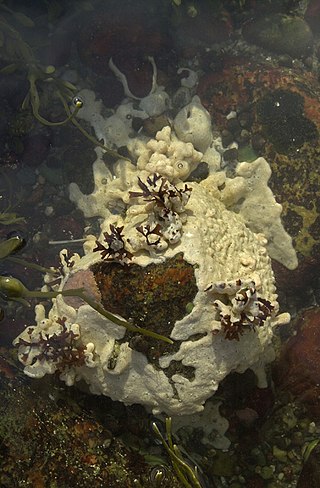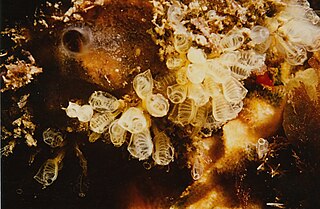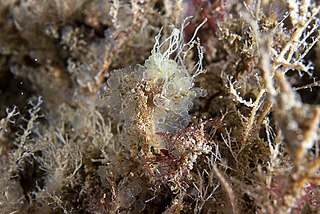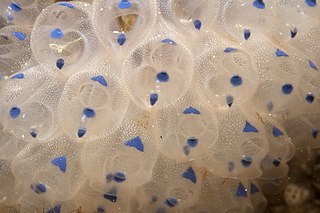
A tunicate is an exclusively marine invertebrate animal, a member of the subphylum Tunicata. This grouping is part of the Chordata, a phylum which includes all animals with dorsal nerve cords and notochords. The subphylum was at one time called Urochordata, and the term urochordates is still sometimes used for these animals. They are the only chordates that have lost their myomeric segmentation, with the possible exception of the seriation of the gill slits. However, doliolids still display segmentation of the muscle bands.

Ascidiacea, commonly known as the ascidians or sea squirts, is a paraphyletic class in the subphylum Tunicata of sac-like marine invertebrate filter feeders. Ascidians are characterized by a tough outer "tunic" made of a polysaccharide.

Pyura is a large genus of sessile ascidians that live in coastal waters at depths of up to 80 m (260 feet). Like all ascidians, Pyura are filter feeders. A few species, including Pyura chilensis are commercially fished.
Sorberacea were a monoorder and monofamilial class of benthic Tunicates. The single order of the class was Aspiraculata, and the single family of that order was Hexacrobylidae. In a taxonomic revision of the Tunicata in 2007, the name "Hexacrobylidae" was declared invalid and members of the family were included in the family Molgulidae in the class Ascidiacea.

Clavelinidae is a family of tunicates in the order Aplousobranchia.

Clavelina is genus of sea squirts, containing the following species:

Aplousobranchia is an order of sea squirts in the class Ascidiacea, first described by Fernando Lahille in 1886. They are colonial animals, and are distinguished from other sea squirts by the presence of relatively simple pharyngeal baskets. This provides the etymology of their name: in ancient greek, ἁ.πλοος-ους (ha.ploos-ous) means "simple". The posterior part of the abdomen contains the heart and gonads, and is typically larger than in other sea squirts.

Clavelina moluccensis, common name bluebell tunicate, blue bell tunicate, or blue sea squirt is a species of tunicate, in the genus Clavelina. Like all ascidians, these sessile animals are filter feeders.

Clavelina robusta is a species of tunicate, in the genus Clavelina. Like all ascidians, these sessile animals are filter feeders.

Didemnum vexillum is a species of colonial tunicate in the family Didemnidae. It is commonly called sea vomit, marine vomit, pancake batter tunicate, or carpet sea squirt. It is thought to be native to Japan, but it has been reported as an invasive species in a number of places in Europe, North America and New Zealand. It is sometimes given the nickname "D. vex" because of the vexing way in which it dominates marine ecosystems when introduced into new locations; however, the species epithet vexillum actually derives from the Latin word for flag, and the species was so named because of the way colonies' long tendrils appear to wave in the water like a flag.
Polyandrocarpa is a genus of ascidian tunicates within the family Styelidae.
Culeolus elegans is a species of ascidian tunicates in the family Pyuridae. It is found in New Caledonia.

Pycnoclavella is a genus of sea squirts first circumscribed by Walter Garstang in 1891. The generic name comes from the Ancient Greek πυκνός (puknós) meaning "closely united". In 1990, Patricia Kott placed Pycnoclavella in its own family, Pycnoclavellidae, but in 2008 it was moved back to Clavelinidae.

Aplidium elegans, the sea-strawberry, is a species of colonial sea squirt, a tunicate that is a benthic invertebrate in the family Polyclinidae and class Ascidiacea. It is native to shallow waters in the Atlantic Ocean and Mediterranean Sea. It is also found in between France and the United Kingdom.

Perophora listeri is a species of colonial sea squirt in the genus Perophora, native to the North Atlantic.

Sycozoa cerebriformis, is a sea squirt in the family Holozoidae, first described by Jean René Constant Quoy and Joseph Paul Gaimard in 1834 as Aplidie cerebriforme. The taxonomic decision which determined the name, Sycozoa cerebriformis, and the species' synonymy was given by Patricia Kott in 1990.

Sycozoa pulchra, is a sea squirt in the family Holozoidae, first described by William Abbott Herdman in 1886 as Colella pulchra. The taxonomic decision which determined the name, Sycozoa pulchra, and the species' synonymy was given by Patricia Kott in 1990.

Clavelina ossipandae, the skeleton panda sea squirt or skeleton panda ascidian, is a species of colonial ascidian, a group of sessile, marine filter-feeding invertebrates. Originally discovered near Kume Island in Japan by local divers, pictures of the animal attracted attention in the media for its appearance prior to its formal taxonomic description in 2024.

Clavelina australis is a species of colonial ascidian from Australia, in the family Clavelinidae.
















